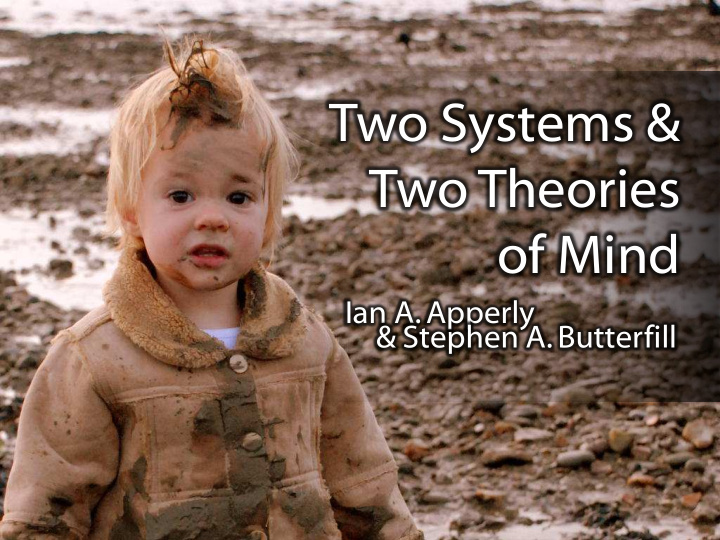



Two Systems & Two Theories of Mind Ian A. Apperly & Stephen A. Butterfill
Are human adults’ abilities to represent beliefs automatic?
Are human adults’ abilities to represent beliefs automatic?
Are human adults’ abilities to represent beliefs automatic? --- no: Back & Apperly (2010), Apperly et al (2010).
Are human adults’ abilities to represent beliefs automatic? --- no: Back & Apperly (2010), Apperly et al (2010). --- yes: Kovács et al (2010), Schneider et al (2011).
Are human adults’ abilities to represent beliefs automatic? --- no: Back & Apperly (2010), Apperly et al (2010). --- yes: Kovács et al (2010), Schneider et al (2011).
Infants’ false-belief tracking abilities Violation of expectations (Onishi & Baillargeon 2005) - with change of location (He et al 2011) - with deceptive contents (Song et al 2008; Scott et al 2012) - observing verbal comm n Anticipating action (Clements et al 1994) - looking (Knudsen & Liszkowski 2011) - pointing Helping (Buttlemann et al 2009) Communicating (Southgate et al 2010) Altercentric interference (Kovacs et al 2010)
Infants’ false-belief tracking abilities Violation of expectations (Onishi & Baillargeon 2005) - with change of location (He et al 2011) - with deceptive contents (Song et al 2008; Scott et al 2012) - observing verbal comm n Anticipating action (Clements et al 1994) - looking A-tasks (Knudsen & Liszkowski 2011) - pointing Helping (Buttlemann et al 2009) Communicating (Southgate et al 2010) Altercentric interference (Kovacs et al 2010)
1. There are subjects who can pass A-tasks 2. These subjects’ success on A-tasks is explained by the fact that they can represent (false) beliefs
3-year-olds fail false belief tasks prediction (Wimmer & Perner 1983) - action (Astington & Gopnik 1991) - desire (Wimmer & Mayringer 1998) retrodiction or explanation (Bartsch & London 2000) select a suitable argument (Gopnik & Slaughter 1991) own beliefs (first person) involvement (deception) (Chandler et al 1989) nonverbal response (Call et al 1999; Low 2010 exp.2) test questions word-for-word (Gopnik et al 1994; identical to desire and pretence Cluster 1996) tasks
3-year-olds fail false belief tasks prediction (Wimmer & Perner 1983) - action (Astington & Gopnik 1991) - desire (Wimmer & Mayringer 1998) retrodiction or explanation (Bartsch & London 2000) select a suitable argument B-tasks (Gopnik & Slaughter 1991) own beliefs (first person) involvement (deception) (Chandler et al 1989) nonverbal response (Call et al 1999; Low 2010 exp.2) test questions word-for-word (Gopnik et al 1994; identical to desire and pretence Cluster 1996) tasks
1. There are subjects who can pass A-tasks but cannot pass B-tasks. 2. These subjects’ success on A-tasks is explained by the fact that they can represent (false) beliefs 3. These subjects’ failure on B-tasks is explained by the fact that they cannot represent (false) beliefs
1. There are subjects who can pass A-tasks but cannot pass B-tasks. 2. These subjects’ success on A-tasks is explained by the fact that they can represent (false) beliefs 3. These subjects’ failure on B-tasks is explained by the fact that they cannot represent (false) beliefs
1. There are subjects who can pass A-tasks but cannot pass B-tasks. 2. These subjects’ success on A-tasks is explained by the fact that they can represent (false) beliefs 3. These subjects’ failure on B-tasks is explained by the fact that they cannot represent (false) beliefs
1. There are subjects who can pass A-tasks but cannot pass B-tasks. 2. These subjects’ success on A-tasks is explained by the fact that they can represent (false) beliefs 3. These subjects’ failure on B-tasks is explained by the fact that they cannot represent (false) beliefs Are human adults’ abilities to represent beliefs automatic? --- no: Back & Apperly (2010), Apperly et al (2010). --- yes: Kovács et al (2010), Schneider et al (2011).
• • – • – • – • – • – • – • •
800 750 Reaction time (ms) 700 Consistent 650 ns Inconsistent * 600 550 500 Self - avatar distractor Self - rectangle distractor Experiment 3
800 750 Reaction time (ms) 700 Consistent 650 ns Inconsistent * 600 550 500 Self - avatar distractor Self - rectangle distractor Experiment 3
But how could mindreading be efficient?
An analogy with practical physics
Examples from the psychology of trajectories v Launch Impact What Newton would have done..... A) Derive equation for trajectory of ball. B) Derive equation for one’s own capacity to move. Solve A and B simultaneously
Examples from the psychology of trajectories McCloskey, Intuitive Physics, Scientific American 248 (1983),
Examples from the psychology of trajectories This naïve theory will often give the correct answer, and is much easier to use McCloskey, Intuitive Physics, Scientific American 248 (1983),
mind Is there an unsophistcated but useful model of the physical?
Recommend
More recommend